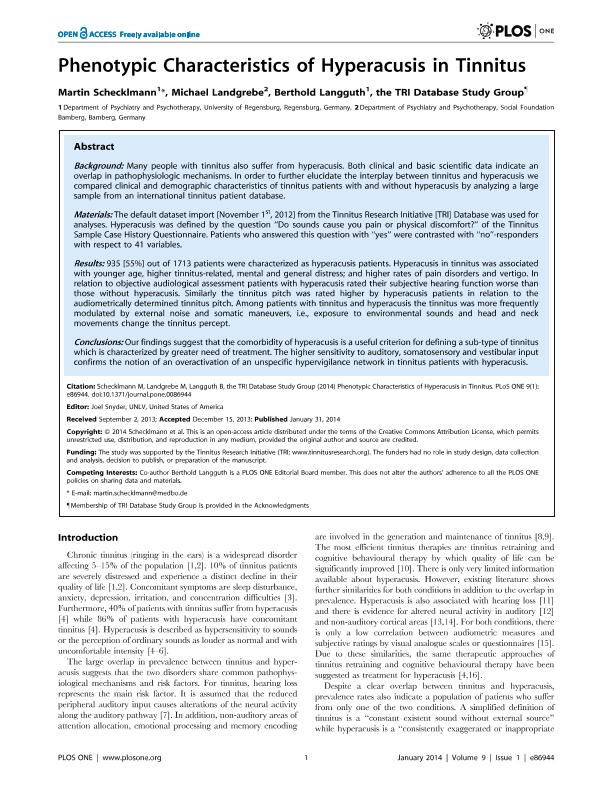Mostrar el registro sencillo del ítem
dc.contributor.author
Schecklmann, Martin
dc.contributor.author
Landgraebe, Michael
dc.contributor.author
Langguth, Berthold
dc.contributor.author
Elgoyhen, Ana Belen

dc.contributor.author
Tinnitus Research Initiative Database Group
dc.date.available
2016-02-02T20:45:34Z
dc.date.issued
2014-02
dc.identifier.citation
Schecklmann, Martin; Landgraebe, Michael; Langguth, Berthold; Elgoyhen, Ana Belen; Tinnitus Research Initiative Database Group; Phenotypic Characteristics of Hyperacusis in Tinnitus; Public Library of Science; Plos One; 9; 1; 2-2014; e86944-e86944
dc.identifier.issn
1932-6203
dc.identifier.uri
http://hdl.handle.net/11336/3973
dc.description.abstract
Background: Many people with tinnitus also suffer from hyperacusis. Both clinical and basic scientific data indicate an overlap in pathophysiologic mechanisms. In order to further elucidate the interplay between tinnitus and hyperacusis we compared clinical and demographic characteristics of tinnitus patients with and without hyperacusis by analyzing a large sample from an international tinnitus patient database.
Materials: The default dataset import [November 1st, 2012] from the Tinnitus Research Initiative [TRI] Database was used for analyses. Hyperacusis was defined by the question “Do sounds cause you pain or physical discomfort?” of the Tinnitus Sample Case History Questionnaire. Patients who answered this question with “yes” were contrasted with “no”-responders with respect to 41 variables.
Results: 935 [55%] out of 1713 patients were characterized as hyperacusis patients. Hyperacusis in tinnitus was associated with younger age, higher tinnitus-related, mental and general distress; and higher rates of pain disorders and vertigo. In relation to objective audiological assessment patients with hyperacusis rated their subjective hearing function worse than those without hyperacusis. Similarly the tinnitus pitch was rated higher by hyperacusis patients in relation to the audiometrically determined tinnitus pitch. Among patients with tinnitus and hyperacusis the tinnitus was more frequently modulated by external noise and somatic maneuvers, i.e., exposure to environmental sounds and head and neck movements change the tinnitus percept.
Conclusions: Our findings suggest that the comorbidity of hyperacusis is a useful criterion for defining a sub-type of tinnitus which is characterized by greater need of treatment. The higher sensitivity to auditory, somatosensory and vestibular input confirms the notion of an overactivation of an unspecific hypervigilance network in tinnitus patients with hyperacusis.
dc.format
application/pdf
dc.language.iso
eng
dc.publisher
Public Library of Science

dc.rights
info:eu-repo/semantics/openAccess
dc.rights.uri
https://creativecommons.org/licenses/by-nc-sa/2.5/ar/
dc.subject
Tinnitus
dc.subject
Hypercusis
dc.subject.classification
Psiquiatría

dc.subject.classification
Medicina Clínica

dc.subject.classification
CIENCIAS MÉDICAS Y DE LA SALUD

dc.title
Phenotypic Characteristics of Hyperacusis in Tinnitus
dc.type
info:eu-repo/semantics/article
dc.type
info:ar-repo/semantics/artículo
dc.type
info:eu-repo/semantics/publishedVersion
dc.date.updated
2016-03-30 10:35:44.97925-03
dc.journal.volume
9
dc.journal.number
1
dc.journal.pagination
e86944-e86944
dc.journal.pais
Estados Unidos

dc.journal.ciudad
San Francisco
dc.description.fil
Fil: Schecklmann, Martin. University of Regensburg. Department of Psychiatry and Psychotherapy; Alemania
dc.description.fil
Fil: Landgraebe, Michael. Social Foundation Bamberg. Department of Psychiatry and Psychotherapy; Alemania
dc.description.fil
Fil: Langguth, Berthold. University of Regensburg. Department of Psychiatry and Psychotherapy; Alemania
dc.description.fil
Fil: Elgoyhen, Ana Belen. Consejo Nacional de Investigaciones Científicas y Técnicas. Instituto de Investigaciones en Ingeniería Genética y Biología Molecular; Argentina. Tinnitus Research Initiative Database Group; Alemania
dc.description.fil
Fil: Tinnitus Research Initiative Database Group.
dc.journal.title
Plos One

dc.relation.alternativeid
info:eu-repo/semantics/altIdentifier/url/http://journals.plos.org/plosone/article?id=10.1371/journal.pone.0086944
dc.relation.alternativeid
info:eu-repo/semantics/altIdentifier/url/http://www.ncbi.nlm.nih.gov/pmc/articles/PMC3908961/
dc.relation.alternativeid
info:eu-repo/semantics/altIdentifier/issn/1932-6203
dc.relation.alternativeid
info:eu-repo/semantics/altIdentifier/doi/http://dx.doi.org/10.1371%2Fjournal.pone.0086944
Archivos asociados
